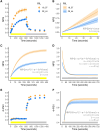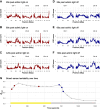A deficient CP24 allele defines variation for dynamic nonphotochemical quenching and photosystem II efficiency in maize
- PMID: 40132112
- PMCID: PMC12018801
- DOI: 10.1093/plcell/koaf063
A deficient CP24 allele defines variation for dynamic nonphotochemical quenching and photosystem II efficiency in maize
Erratum in
-
Correction to: A deficient CP24 allele defines variation for dynamic nonphotochemical quenching and photosystem II efficiency in maize.Plant Cell. 2025 Jun 4;37(6):koaf158. doi: 10.1093/plcell/koaf158. Plant Cell. 2025. PMID: 40554693 Free PMC article. No abstract available.
Abstract
Maize (Zea mays L.) is a global crop species in which CO2 assimilation occurs via the C4 pathway. C4 photosynthesis is typically more efficient than C3 photosynthesis under warm and dry conditions; however, despite this inherent advantage, considerable variation remains in photosynthetic efficiency for C4 species that could be leveraged to benefit crop performance. Here, we investigate the genetic architecture of nonphotochemical quenching (NPQ) and photosystem II (PSII) efficiency using a combination of high-throughput phenotyping and quantitative trait loci (QTL) mapping in a field-grown Multi-parent Advanced Generation Inter-Cross (MAGIC) mapping population. QTL mapping was followed by the identification of putative candidate genes using a combination of genomics, transcriptomics, protein biochemistry, and targeted physiological phenotyping. We identified four genes with a putative causal role in the observed QTL effects. The highest confidence causal gene was found for a large effect QTL for photosynthetic efficiency on chromosome 10, which was underpinned by allelic variation in the expression of the minor PSII antenna protein light harvesting complex photosystem II subunit (LHCB6 or CP24), mainly driven by poor expression associated with the haplotype of the F7 founder line. The historical role of this line in breeding for early flowering time may suggest that the presence of this deficient allele could be enriched in temperate maize germplasm. These findings advance our understanding of the genetic basis of NPQ and PSII efficiency in C4 plants and highlight the potential for breeding strategies aimed at optimizing photosynthetic efficiency in maize.
© The Author(s) 2025. Published by Oxford University Press on behalf of American Society of Plant Biologists.
Conflict of interest statement
Conflict of interest statement. None declared.
Figures






Similar articles
-
Functional relocation of the maize chloroplast atpB gene to the nucleus restores photosynthetic competence to a gene-edited non-photosynthetic mutant.Plant Biotechnol J. 2025 Sep;23(9):3510-3523. doi: 10.1111/pbi.70175. Epub 2025 Jun 4. Plant Biotechnol J. 2025. PMID: 40467523 Free PMC article.
-
Phenome-to-genome insights for evaluating root system architecture in field studies of maize.Plant Genome. 2025 Sep;18(3):e70100. doi: 10.1002/tpg2.70100. Plant Genome. 2025. PMID: 40851219 Free PMC article.
-
Identification of key candidate genes regulating hundred-grain weight in the maize inbred line Ye107 from Southern China.Plant Cell Rep. 2025 Sep 1;44(9):206. doi: 10.1007/s00299-025-03595-7. Plant Cell Rep. 2025. PMID: 40888956 Free PMC article.
-
Systemic pharmacological treatments for chronic plaque psoriasis: a network meta-analysis.Cochrane Database Syst Rev. 2021 Apr 19;4(4):CD011535. doi: 10.1002/14651858.CD011535.pub4. Cochrane Database Syst Rev. 2021. Update in: Cochrane Database Syst Rev. 2022 May 23;5:CD011535. doi: 10.1002/14651858.CD011535.pub5. PMID: 33871055 Free PMC article. Updated.
-
Signs and symptoms to determine if a patient presenting in primary care or hospital outpatient settings has COVID-19.Cochrane Database Syst Rev. 2022 May 20;5(5):CD013665. doi: 10.1002/14651858.CD013665.pub3. Cochrane Database Syst Rev. 2022. PMID: 35593186 Free PMC article.
Cited by
-
Genetic basis of Fusarium ear rot resistance and productivity traits in a heterozygous multi-parent recombinant inbred intercross (RIX) maize population.BMC Plant Biol. 2025 May 15;25(1):639. doi: 10.1186/s12870-025-06684-7. BMC Plant Biol. 2025. PMID: 40375124 Free PMC article.
-
Nonphotochemical quenching changes with abiotic stressor and developmental stages.bioRxiv [Preprint]. 2025 May 18:2025.05.14.654125. doi: 10.1101/2025.05.14.654125. bioRxiv. 2025. PMID: 40462976 Free PMC article. Preprint.
References
-
- Andrews S. FastQC: a quality control tool for high throughput sequence data. v0.12.1 [2010]. https://www.bioinformatics.babraham.ac.uk/projects/fastqc/.
MeSH terms
Substances
Grants and funding
LinkOut - more resources
Full Text Sources
Miscellaneous

